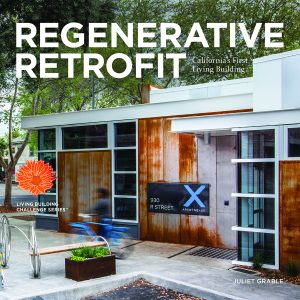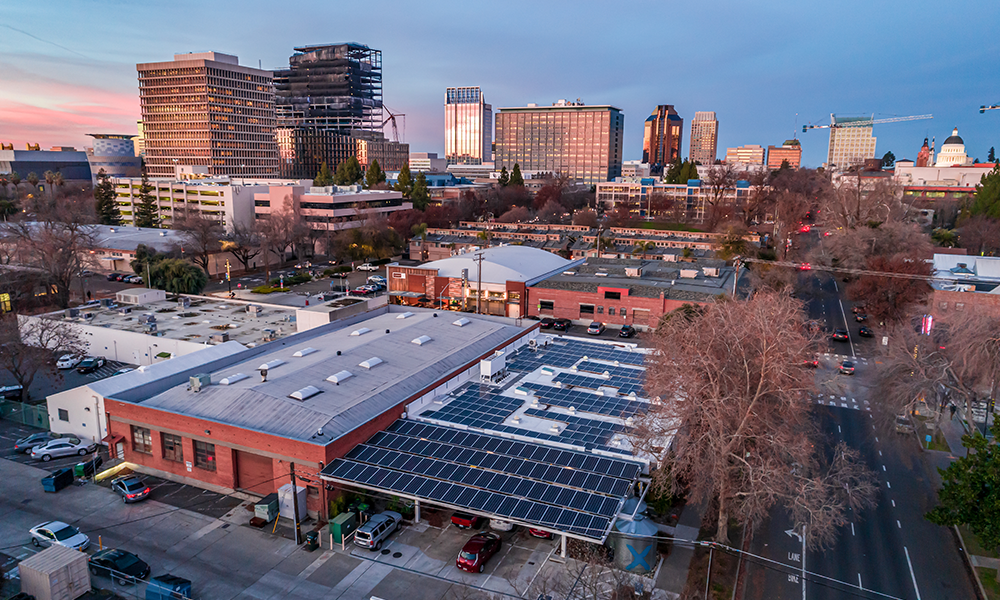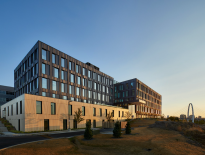Editor’s note: As part of the build-up to our Zero Carbon Conference, October 7-8, our Standards + Policy Director Andrew Lee reviews the newest book release from ILFI’s Ecotone Publishing through the lens of decarbonization. Order your copy of the book and sign up for the conference today to become a Zero Carbon Champion!
* * *
Ecotone Publishing’s most recent addition to the Living Building Challenge Series, titled Regenerative Retrofit: California’s First Living Building details the story of architecture firm Arch Nexus in developing the state’s first Living Building Challenge (LBC) certified building.

The Sacramento-based project is striking in its elegance and depth, showcasing an array of leading-edge design approaches and systems that address each Petal of the LBC program. However, what struck me most is the Arch Nexus SAC’s significance as a replicable model for building decarbonization.
Authentic building decarbonization requires neutralizing two impact areas: operational carbon and embodied carbon. Operational carbon encompasses the emissions associated with all energy consumed by a building. Embodied carbon accounts for all emissions associated with the production and installation of materials utilized for the building construction. Both impact areas are addressed through the Energy Petal requirements of the Living Building Challenge 4.0 and the Zero Carbon standard. And both areas are central to the sustainability strategy for the Arch Nexus Sacramento office project.
For context, Arch Nexus SAC is an adaptive reuse of a one-story 8,200 square foot warehouse building in the R Street corridor of Sacramento, California. Completed in December of 2016, the project followed the firm’s 2010 redevelopment of a 1950s concrete block structure into a class-leading green building for its Salt Lake City office. The Regenerative Retrofit book outlines how everything about the Arch Nexus SAC project was a step forward for the firm’s commitment to sustainable design, notably due to the experience they gained as a building owner and operator of its Salt Lake City office.
The decision Arch Nexus made to renovate not one, but two existing buildings is particularly important as a model for decarbonizing the building sector. Existing buildings are projected to continue to represent up to two-thirds of the building stock by 2050, the date by when climate scientists have called for all sectors of the global economy to reach net zero emissions. Further, it is known that low-rise projects like the Arch Nexus SAC building already represent the majority of the building sector; some estimates peg this typology as making up over 98% of the buildings in cities and contributing up to half of all urban building energy and greenhouse gas emissions.
The Arch Nexus SAC project approach to building decarbonization hinged on two important decisions: to significantly improve the energy performance of an existing building, and to reuse a large portion of the existing structure.
As outlined in the book by author Juliet Grable, Arch Nexus made an early firm-wide commitment to operational excellence that enabled it to achieve the highest marks of energy efficiency for the SAC office project. Many of the lessons the firm learned in troubleshooting its Salt Lake City office were carried over to this new project, including the development of a custom occupant engagement and training platform for use by the firm’s staff to ensure they operated systems as intended. This occupant behaviour strategy was combined with an enhanced building envelope, which included filling existing 2×6 wall cavities with batt insulation, adding rigid insulation and sealing the exterior with a Prosoco weather barrier system. Together, the project team was able to achieve an impressive energy use intensity (EUI) of 26 kBtu per square foot per year, far lower than the predicted EUI of 36, which was already half of the typical small office building in the United States. Further, the team ensured that combustion was eliminated from all new HVAC systems and that the roof could accommodate sufficient photovoltaic (PV) systems to meet the energy budget. After the first year, the SAC office produced 179 percent of its energy use, demonstrating net positive energy and full decarbonization of its operations.
As the book states, the decision to reuse the existing building “saved tens of thousands of pounds of materials from the landfill.” While this level of waste reduction is notable, it is even more significant as an embodied carbon reduction strategy; the original structure holds the bulk of materials that might otherwise contribute the majority of embodied carbon emissions in a new building. Arch Nexus further limited new embodied carbon emissions through material reductions beyond the structure. For example, floors were finished as sealed concrete instead of carpeting, and ceilings were left open with exposed systems in place of installing ceiling tiles or drywall. Arch Nexus continued its embodied carbon reduction through a material selection process that prioritized materials by relative carbon intensity: salvage was preferred over wood; wood over steel; and steel over concrete. Through this process, the firm identified 15 distinct materials that could be salvaged, and these reused materials represented over 72 percent of the total materials palette. Taken together, this rigorous approach to materials reuse, reduction, and responsible selection make the Arch Nexus SAC project an extremely low embodied carbon building that could be neutralized by modest carbon offsets.
By showcasing these achievements of the Arch Nexus team, Regenerative Retrofit demonstrates two things. First, that Living Buildings are exemplary models for building decarbonization. They neutralize operational carbon by operating efficiently, eliminating on-site combustion, and utilizing renewables for all energy; they neutralize embodied carbon by reusing or responsibly procuring materials, and offsetting all remaining emissions. Second, it shows that making a climate-positive impact is not only feasible but preferable when costs and impacts are considered holistically. I commend the Arch Nexus team for demonstrating their commitment through this project and sharing their story in Regenerative Retrofit.



